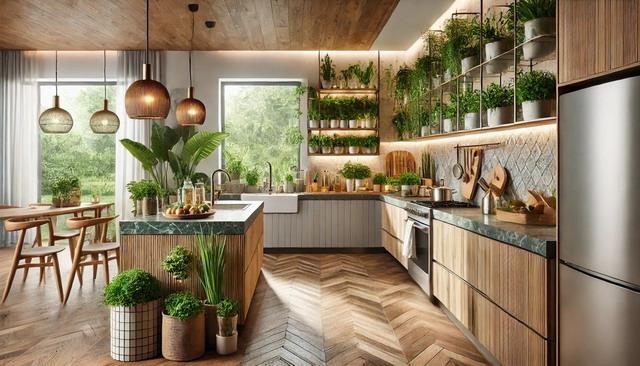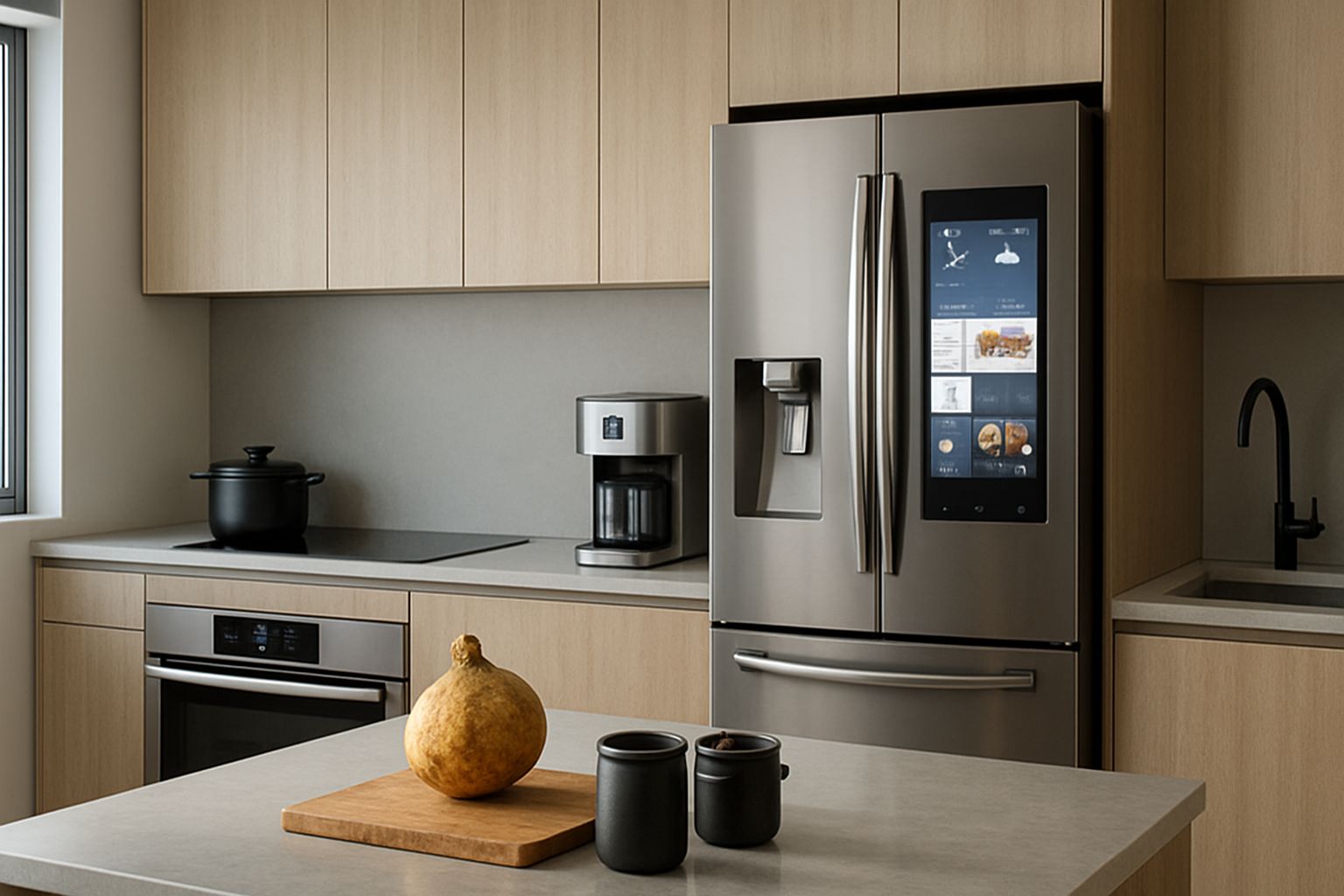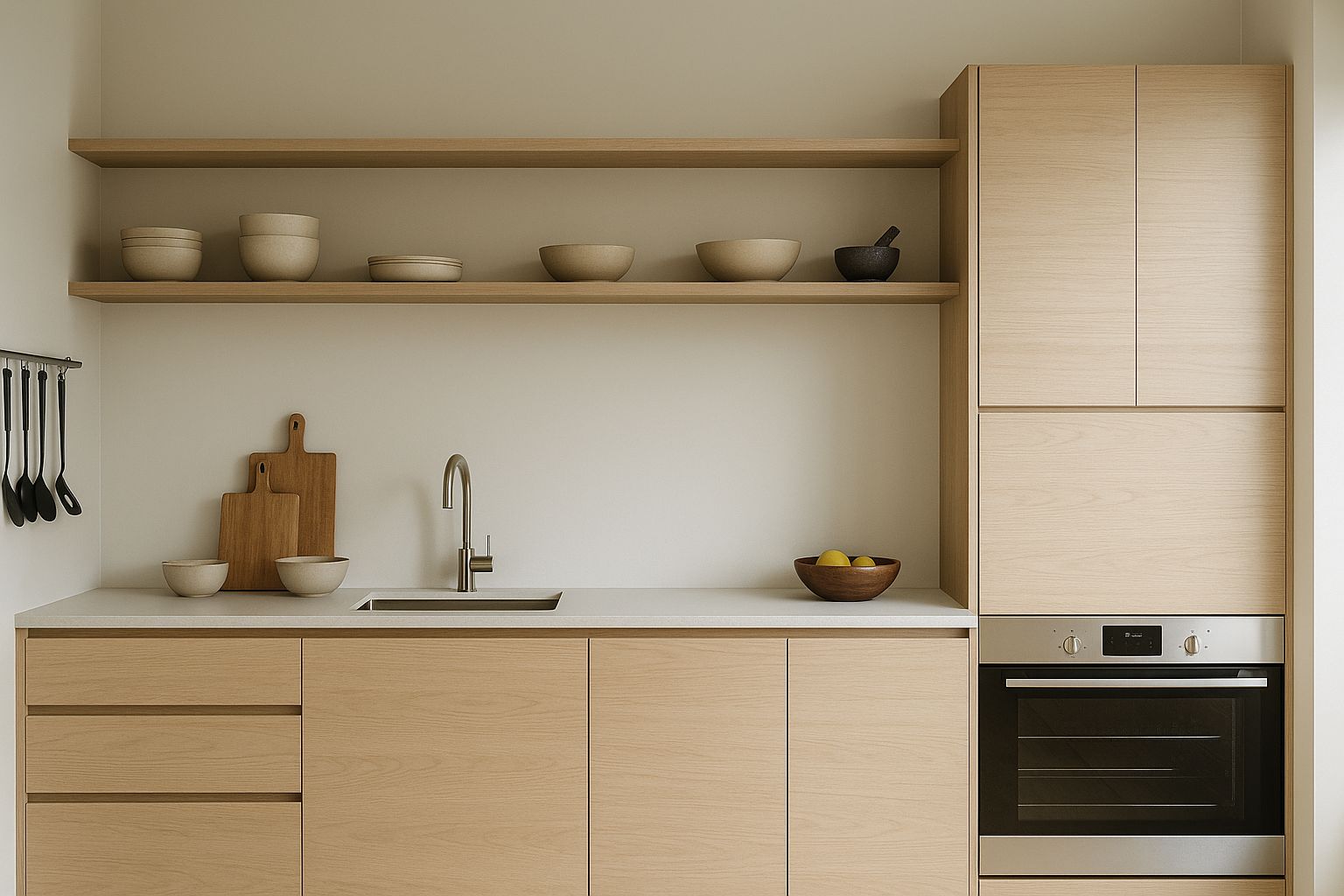Sustainability in kitchen design is evolving rapidly, reflecting a growing consumer demand for eco-friendly options. By 2026, kitchen materials will increasingly focus on renewable sources, recyclability, and innovative production techniques. As homeowners seek stylish yet sustainable solutions, they will find a variety of materials that meet both aesthetic and environmental goals.
The integration of durable, low-impact materials will shape kitchen spaces in ways that prioritize longevity and minimal environmental footprint. Companies will respond to this trend by adopting stricter certification standards and eco-friendly practices in their production processes. The result will be kitchens that marry modern design with sustainable living.
As the market adapts to these evolving preferences, notable innovations will emerge that redefine traditional kitchen aesthetics. Sustainable choices will not just be a trend but a fundamental aspect of how kitchens are designed and constructed, making a lasting impact on the industry.
Key Takeaways
- Sustainable materials will prioritize renewability and recyclability by 2026.
- Design innovations will enhance functionality while minimizing environmental impact.
- Consumer preferences will significantly drive market changes in kitchen materials.
Evolution of Sustainable Kitchen Materials
The demand for sustainable kitchen materials has evolved significantly over the years. Initially, this trend focused on eco-friendly sourcing and recyclability.
Materials like bamboo, recycled wood, and metal began to gain traction. These materials are favored for their low environmental impact and durability.
Key Developments:
- Bamboo: Fast-growing and renewable, it is now used for countertops and cabinetry.
- Recycled Glass: This material is increasingly popular in countertops and backsplashes. It reduces landfill waste while offering aesthetic appeal.
- Reclaimed Wood: Sourced from old buildings and furniture, it adds character and reduces demand for new lumber.
Innovations in technology have led to new materials gaining prominence. Biocomposites and biodegradable options are emerging as viable alternatives.
Notable Innovations:
- Bioplastics: Derived from plant materials, they are often used in kitchen accessories and utensils.
- Eco-Friendly Paints and Finishes: These products minimize VOC emissions, contributing to healthier indoor air quality.
As awareness of environmental issues rises, the sustainable kitchen materials market is likely to continue its trajectory toward more eco-conscious choices. These trends reflect a significant shift in consumer priorities towards sustainability in home design.
Sustainable Material Sourcing
Sustainable material sourcing emphasizes the importance of local initiatives and the implications of global supply chains. This approach not only supports environmental goals but also fosters community engagement and economic resilience.
Local Sourcing Initiatives
Local sourcing involves obtaining materials from nearby suppliers, which reduces transportation emissions and supports the local economy. As consumers become more environmentally conscious, companies are increasingly prioritizing materials produced within a specified radius.
Community initiatives often promote the use of locally sourced materials, highlighting species native to the area. For example, reclaimed wood from local buildings can be repurposed for cabinets and countertops. This not only preserves local heritage but also minimizes waste.
Additionally, farmers or manufacturers may engage in practices that meet sustainability certifications, such as organic or Fair Trade. This enhances consumer trust and encourages a commitment to sustainable practices.
Impact of Global Supply Chains
Global supply chains present significant challenges in sustainable material sourcing. The transportation of materials over long distances contributes to carbon emissions. This has led to a reevaluation of sourcing practices to mitigate environmental impact.
Issues like labor conditions and environmental regulations can vary widely between countries. It is crucial for companies to ensure responsible sourcing that aligns with sustainability goals. This often includes audits and certifications to verify the environmental credentials of suppliers.
Additionally, reliance on international suppliers can lead to disruptions, as seen during recent global crises. Companies are increasingly looking for diversified sourcing strategies that balance cost-efficiency with sustainability. This hybrid approach can foster resilience against potential supply chain shocks.
Innovative Recyclable Materials
The demand for sustainable kitchen materials continues to rise, with innovative recyclable options leading the way. These materials help reduce waste and promote a circular economy, making them crucial for eco-conscious consumers.
Bioplastics and Composites
Bioplastics, derived from renewable resources, are gaining traction as a sustainable alternative to traditional plastics. Made from materials like corn starch or sugarcane, they can be composted or recycled, reducing environmental impact.
Composites made from recycled fibers and bioplastics offer durability and aesthetic appeal. These materials are increasingly used in cabinetry and countertops, providing a stylish yet sustainable option for kitchens. They are lightweight, resistant to moisture, and can be manufactured in various colors and textures to suit any design.
Recycled Metals and Alloys
Recycled metals, such as aluminum and stainless steel, have become popular for kitchen fixtures and appliances. Obtaining metal from scrap significantly conserves energy when compared to extracting raw materials.
Alloys that incorporate recycled content offer strength and longevity, making them ideal for high-use kitchen items. These materials are often sustainable and can be beautifully finished to enhance the overall kitchen design. Additionally, they are easy to clean, resistant to corrosion, and can be fully recycled at the end of their lifecycle, contributing to a more sustainable future.
Renewable Material Integration
The integration of renewable materials in kitchen design emphasizes both environmental responsibility and aesthetic appeal. Key materials like bamboo and cork are gaining traction, alongside sustainably sourced wood, offering innovative choices for homeowners.
Bamboo and Cork
Bamboo is rapidly becoming a preferred choice in sustainable kitchens due to its rapid growth cycle. It can reach maturity in just three to five years, making it an excellent renewable resource. Its natural strength, durability, and versatility allow it to be used in countertops, cabinetry, and flooring.
Cork, harvested from the bark of cork oak trees, is another sustainable material. It is lightweight and resistant to moisture, making it ideal for kitchen applications. The harvesting process does not harm the tree, enabling it to regenerate every nine years. Both materials offer unique textures and finishes that enhance the kitchen’s aesthetic while ensuring ecological responsibility.
Forestry Stewardship and Woods
Sustainably sourced wood is crucial for eco-friendly kitchen designs. Trees harvested from responsibly managed forests ensure that the ecosystem remains balanced. Certification systems like the Forest Stewardship Council (FSC) guarantee that wood products meet strict environmental and social standards.
Using reclaimed or recycled wood further reduces environmental impact. This practice adds character and history to kitchen structures. It is essential to consider the source of wood materials to ensure they contribute positively to sustainability efforts. Emphasizing these practices in kitchen renovations and constructions helps promote a greener future.
Eco-Friendly Production Techniques
Innovations in eco-friendly production techniques are crucial for developing sustainable kitchen materials. Techniques focus on minimizing environmental impact and enhancing resource efficiency.
Low-Emission Manufacturing
Low-emission manufacturing processes significantly reduce greenhouse gas emissions. These methods utilize renewable energy sources, such as solar or wind power, to minimize reliance on fossil fuels.
Manufacturers are increasingly adopting advanced machinery that operates with higher efficiency, further lowering emissions.
Techniques like 3D printing can also optimize resource usage, creating materials layer by layer and minimizing waste. This approach allows for customized designs that meet specific needs, ensuring that materials are not produced in excess.
Additionally, companies are implementing carbon capture technologies, where emissions are captured and reused. This method not only curtails pollution but can also convert waste into useful resources.
Waste-Reducing Technologies
Waste-reducing technologies focus on minimizing material waste during production. Implementing closed-loop systems ensures that by-products are recycled and reused within the manufacturing process.
For instance, some manufacturers use biomass as a feedstock, converting agricultural waste into raw materials for kitchen products.
Using digital simulations can also help optimize the cutting processes, ensuring precision and reducing excess materials.
Additionally, innovations like just-in-time manufacturing enable businesses to produce based on actual demand rather than projected needs. This method reduces overproduction and waste, contributing to a more sustainable approach in the industry.
By focusing on efficient resource management, these technologies create a more sustainable production landscape for kitchen materials.
Durability and Lifespan of Materials
Durability is a crucial factor in sustainable kitchen materials. Materials that withstand wear and tear reduce the need for frequent replacements.
Key Durable Materials:
- Bamboo: Known for its high strength-to-weight ratio and resilience.
- Recycled Steel: Resistant to corrosion and provides longevity.
- Quartz: Non-porous and highly durable, making it ideal for countertops.
The lifespan of sustainable materials often surpasses conventional options. For example, bamboo can last up to 15 years when properly maintained. In contrast, common wood may need replacement every 5 to 10 years.
Factors Impacting Lifespan:
- Maintenance: Regular care can prolong the durability of materials.
- Climate Resistance: Some materials perform better in humid or dry environments.
- Structural Strength: Materials like recycled aluminum offer excellent structural integrity.
Opting for durable materials leads to a reduced environmental impact. Fewer replacements result in less waste and lower resource consumption over time.
Investing in high-quality, sustainable kitchen materials ensures longevity and performance, aligning with eco-friendly practices.
Design Trends in Sustainable Kitchens
Sustainable kitchen designs are evolving, emphasizing efficiency and eco-friendliness. Two prominent trends include modular and adaptable designs alongside minimalist and functional aesthetics.
Modular and Adaptable Designs
Modular kitchen systems allow customization and flexibility. Homeowners can adjust layouts as needs change, enhancing usability without extensive renovations.
These designs utilize sustainable materials like reclaimed wood and recycled metals, reducing environmental impacts. With options such as interchangeable cabinetry and movable islands, users can reconfigure spaces easily.
This approach aligns with the growing demand for versatile living spaces that accommodate both cooking and socializing. Features like integrated storage solutions further enhance efficiency, ensuring every inch of space is maximized.
Minimalist and Functional Aesthetics
Minimalism in kitchen design focuses on clean lines and simplicity. This trend prioritizes functional beauty, minimizing clutter and maximizing space.
The use of neutral color palettes and natural materials helps create a serene environment. These choices promote a connection with nature and sustainable practices.
Additionally, energy-efficient appliances are often integrated seamlessly into the design, emphasizing functionality. By combining aesthetics with practicality, these kitchens foster a harmonious atmosphere, appealing to modern sensibilities while supporting environmentally responsible living.
Consumer Preferences and Market Demand
Consumer preferences are evolving towards sustainability in kitchen materials. Increasing awareness of environmental issues is shaping purchasing decisions.
Surveys indicate a strong interest in eco-friendly options. Key materials gaining traction include:
- Bamboo: Rapidly renewable and durable.
- Recycled Metal: Reduces waste and energy consumption.
- Reclaimed Wood: Unique aesthetics with minimal environmental impact.
Price sensitivity remains a factor. Many consumers are willing to pay more for sustainable options, yet affordability is crucial.
Brand transparency is also important. Consumers prefer companies that provide clear information about sourcing and sustainability practices.
In the competitive market, innovation plays a significant role. Products that combine sustainability with modern design attract more attention.
The rise of sustainable living influencers further drives demand. They educate their communities on the benefits of choosing green materials for kitchens.
Retailers are responding by expanding their sustainable product lines. This shift engages a broader audience, reflecting a growing desire for eco-conscious living.
As these trends continue, the market for sustainable kitchen materials is expected to grow. Adaptability will be essential for manufacturers to meet evolving consumer expectations.
Regulatory Impact and Certification Standards
Regulatory frameworks and certification standards are crucial in guiding sustainable kitchen material choices. These elements ensure that materials are safe, efficient, and beneficial for the environment.
LEED and Green Building Codes
LEED (Leadership in Energy and Environmental Design) is a prominent certification system that evaluates the sustainability of buildings, including their kitchen spaces. The program grades projects based on energy efficiency, water conservation, and use of sustainable materials.
Green building codes vary by jurisdiction but often incorporate LEED standards. Compliance with these codes mandates the use of materials that meet specific environmental benchmarks. For instance, builders might choose countertops made from recycled content or cabinets crafted from sustainably sourced wood.
Adhering to LEED guidelines not only enhances a project’s sustainability rating but can also lead to financial incentives, such as tax credits or grants.
Material Safety and Health Certifications
Health certifications focus on the impacts materials have on human safety and indoor air quality. Standards such as GreenGuard or the EPA’s Safer Choice label indicate that products have been tested for harmful emissions.
Kitchen materials that bear these certifications are particularly valuable in residential settings. They ensure that finishes, adhesives, and paints do not contribute to indoor pollution.
Additionally, certifications like Cradle to Cradle assess the lifecycle impact of products, ensuring that materials can be safely reused or recycled. Selecting certified materials promotes a healthier living environment while supporting sustainable development initiatives.
Technology in Sustainable Material Fabrication
Advancements in technology are shaping the future of sustainable material fabrication. Innovations such as 3D printing and AI-assisted production are becoming essential in creating eco-friendly kitchen materials.
3D Printing with Sustainable Materials
3D printing is a transformative technology in sustainable fabrication. This process allows the use of biodegradable and recycled materials, reducing waste significantly. For instance, companies are exploring bioplastics derived from corn starch or seaweed, which decompose naturally.
Moreover, 3D printing minimizes excess material usage. Design flexibility enables customized products tailored to specific needs, further enhancing efficiency. Brands are increasingly adopting on-demand production, eliminating the need for bulk manufacturing, thus saving resources and reducing carbon footprints.
Automated and AI-assisted Production
Automated and AI-assisted production processes are revolutionizing sustainable materials development. These technologies enhance precision and efficiency, reducing resource consumption during fabrication.
AI systems can optimize material selection based on sustainability metrics, ensuring eco-friendliness in production. Additionally, automation reduces human error and waste, resulting in a more streamlined approach to manufacturing sustainable kitchen materials.
Many manufacturers are implementing smart technology for monitoring energy use, identifying areas for improvement. This focus on efficiency not only supports sustainability goals but also reduces operational costs, benefiting both the environment and the business.
Case Studies: Innovators in Sustainability
Many companies are leading the way in sustainable kitchen materials through innovative practices. These innovators are transforming the industry by prioritizing eco-friendliness in design and production.
- IKEA
IKEA has committed to using only renewable or recycled materials by 2030. This includes sourcing sustainable wood and leveraging innovative processes to reduce waste. Their efforts contribute to a circular economy. - Cosentino
Cosentino manufactures surfaces using recycled materials. Their Silestone line incorporates 25% recycled content, significantly reducing the environmental impact. They also utilize a water recycling system in production. - Formica
Formica has introduced laminate products made from post-consumer wood fiber. This reduces landfill waste and encourages responsible sourcing. Their sustainable initiatives showcase new possibilities in countertop materials. - LG Hausys
LG Hausys focuses on eco-friendly designs in kitchen surfaces. The company produces materials that are recyclable and contain a lower environmental impact. They utilize manufacturing technologies that conserve energy.
These case studies reveal the potential for innovation in sustainable kitchen materials. As industries adapt, these leaders serve as examples for future developments. Their approaches can inspire others to embrace sustainability in kitchen design.









